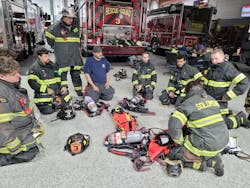Turbocharge Your Firefighting Drills: Leveraging Skill Refinement and Leadership Development
Drill night. It’s one of the best and most common ways to practice and learn skills as a team. Not only do we knock off the rust for competencies that we might not have used in some time, but we also get to practice scenario-based situations to build teamwork and comradery. These benefits alone justify drill night’s continued existence. However, what if there were a way to turbocharge the traditional drill into a leadership development and skill refinement opportunity?
Skill refinement opportunity
To achieve skill mastery, the traditional adage is “See one. Do one. Teach one.” This learning theory, which is prominent in the medical field and in hands-on skill-based education, incorporates observation, practice and teaching to build reinforcement and refinement toward the goal of achieving mastery. First, learners see the task carried out by an experienced individual, who explains and breaks down each step of the task. Second, learners complete the task themselves (typically, supervised) to build muscle memory and develop tacit knowledge. Third, leaners become the teacher by organizing their knowledge and explaining the task themselves. In this way, as learners teach, they solidify their understanding and proficiency to truly internalize the knowledge. This practice is grounded in the learning principles of active learning, a constructivist approach that builds knowledge from experience and reflection, from reinforcement by building off each previous step and from feedback.
Typically, drills are led by a department officer as an assigned duty. By design, each department is composed of a smaller ratio of officers to regular running members. This isn’t news to most people. What might be is the fact that, because of the hierarchy, this means that only a small percentage of membership is afforded the opportunity to completely master their skill base. Put simply, officers who are in charge of leading drills complete all three steps of the learning theory, while regular running members might not completely master skills, because they aren’t given the opportunity to complete the final step: teach one. This can cause a lack of true internalization and hardwiring of the skill. Why not allow regular running members the opportunity to teach drills?
Leadership development opportunity
Operational officers are selected, elected and promoted based in part on their tactical proficiency on scene. Another facet to consider, particularly with chief officers, is their ability to develop and coach officers who report to them.
Coaching is a unique skill set for senior officers that’s pivotal in the overall growth of a department and succession planning. Coaching involves the facilitation of growth for a “coachee” through the enablement of decision-making; critical thinking; not giving the answer and allowing the individual to work through the problem; and the ability to fail in a safe space to learn from mistakes. Essentially, it’s guiding a coachee instead of explicitly telling that individual how to do everything step—the opposite of micromanaging. Coaching has profound benefits, principally improving the problem-solving and decision-making ability of the coachee.
Like any skill, coaching must be practiced to achieve proficiency. One way to help newer officers practice coaching is through drills. As proposed above, if drills are led by regular running members to complete their skill mastery, this provides an opportunity for officer coaching as well. Officers can act as a sponsor for the drill and practice their coaching skills through support and guidance of the regular running member. This includes helping that person with choice of topic; practicing skills in the drill for readiness; outlining a general lesson plan and agenda for the drill; providing moral support at the drill; and providing a critique to the member afterward on things that went well and that could be improved and how to go about this improvement. In this way, officers are practicing their coaching skills for future use once promoted to a higher position, where these skills will be needed to help coach other officers that report directly to them.
Turbocharged drill outline
Here is a general outline for how this process can be operationalized:
· Who? Attendance should include members who seek to have rookie books filled out, members who seek to get checked off on apparatus and members who seek to brush up on skills.
In terms of nonofficer instructors, ensure that these members have the maturity and competency that are needed to fill the temporary role. Once that’s been covered, the goal should be for these people to complete skill mastery through teaching; to build leadership competency in rising members; to provide the opportunity to become familiarized with running a drill, teaching and passing along knowledge to the next generation; and to build the engagement of the membership outside of officers.
The goal for sponsors (read: officers) is to build the mentorship and coaching skills of officers in leading staff.
The program lead/training officer coordinates the schedule for when the sessions will occur and who will be the instructor and the sponsor; solidifies the topic; and communicates with the membership.
- What? A skills-based drill that has a specific scope and that’s aimed at building confidence/recall in skills before they become rusty. This will be a judgment-free zone.
Sessions consist of two parts. Part 1 is led by the instructor. This person either is given the topic or chooses the topic him/herself and researches/plans the session under the mentorship of the sponsor. The structure requires that everyone has the opportunity for hands-on training in multiples for repetition.
The instructor must be given the opportunity to operate in a temporary leadership position, with limited interjections by other members and officers. The sponsor may interject if any safety concerns arise.
Part 2 is led by the sponsor. This person gives any member the opportunity to get checked off on a rookie book skill or get turned over for a piece of apparatus.
After the session is complete, the sponsor gives the instructor a 10-minute critique in a private setting. What went well? What didn’t? How can the instructor improve?
- When? Monthly, second Friday, 7:00 p.m. to 9:00 p.m.
- Where? Engine-bay, training prop, classroom.
- Why? To provide the opportunity to build the engagement and teamwork atmosphere of the membership; provide the opportunity for members to brush up on their skills and fundamentals without judgment; provide a designated time for those who wish to get checked off the opportunity to do so; provide leadership opportunities for nonofficers to participate and build competency (this way, if any members would like to become an officer in the future, they now have experience in leading others); provide the opportunity for nonofficers to master their skill-base through teaching by completing the learning theory cycle; provide the opportunity for officers to practice mentorship and coaching skills (including resisting over-directing on tasks), practicing guiding others to think critically and make decisions for themselves (not simply giving the answer) and providing an opportunity to fail and learn from mistakes in a safe environment.
Developing and refining skill mastery
Most members aren’t officers and, therefore, aren’t afforded the opportunity to teach or run drills to the same extent that an operational officer is. If we don’t provide an opportunity for members to teach in some capacity, they aren’t mastering the skills that they acquire fully. Utilizing a drill by leveraging the learning theory model provides the opportunity to fulfill the last link in the chain by giving members the opportunity to participate in a teaching capacity, which provides a development opportunity in the form of skill mastery and refinement.
Although operational officers might have ample experience in on-scene responsibilities and management, coaching and developing other members and other officers who are direct reports aren’t as intuitive. This is one of the facets that differentiates a manager from a leader. A manager allocates resources to achieve a goal; a leader accomplishes this plus motivates and develops staff. Utilization of a drill that has the officer occupying the coaching/sponsor role provides the officer practice and experience in leadership development via coaching practice.
Using a drill in this manner can turbocharge the benefits to include not only practice and teamwork but skill refinement and leadership development as well. This method boosts both individual proficiency and officer growth, transforming traditional drills into powerful development opportunities.
About the Author

David Hupp
David Hupp has been in the fire service for 12 years as a volunteer firefighter/EMT and currently is an active member at and a member of the board of directors for the Solomons Volunteer Rescue Squad and Fire Department, which is in Calvert County, MD. Hupp has a doctorate in business administration-healthcare management, a master's degree in business administration and a bachelor's degree in business administration. He also has improvement certifications as a LEAN Six Sigma Black Belt and a Certified Professional in Healthcare Quality. Hupp also has 12 years' experience in the healthcare field and is employed at The Johns Hopkins Hospital as a senior quality improvement team leader, where he focuses on process improvement, hospital efficiencies and patient safety. He is the author of "V.I.P.E.R. Improvement: Fire/EMS Leadership and Management," which uses business improvement tools to drive improved problem-solving and decision-making. The book is the recipient of the Regal Summit Book Award and is an award finalist for the Next Generation Indie Book Award in the business and career categories.
